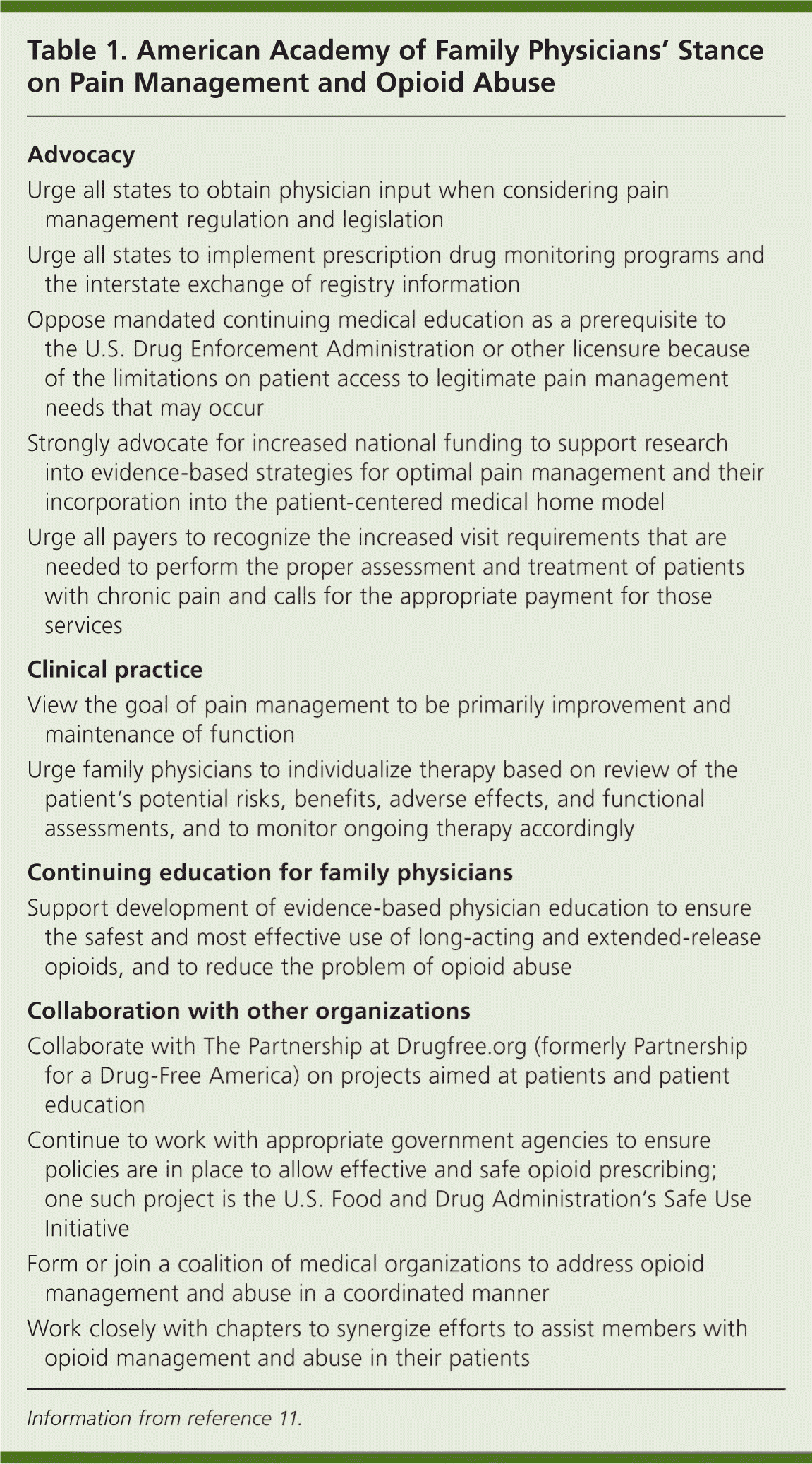
Am Fam Physician. 2012;86(7):600-602
See related article Rational Use of Opioids for Management of Chronic Nonterminal Pain, the AFP By Topic module on chronic pain, and information and resources on pain management and opioid abuse from the AAFP.
Author disclosure: No relevant financial affiliations to disclose.
Chronic nonmalignant pain affects a significant number of Americans. In addition to physical discomfort, chronic pain leads to work absenteeism, family disruption, and impairment of activities of daily living, resulting in secondary depression, social isolation, and low self-esteem, among other consequences.
Concurrent with the increased need for pain management is a considerable increase in the use of prescription pain relievers for nonmedical purposes. Nonmedical use of prescription pain relievers is now the second most common form of drug abuse (not including alcohol), exceeded only by marijuana use.1 The most recent statistics indicate that in 2007, an estimated 5.2 million individuals older than 12 years reported nonmedical use of prescription pain relievers during the preceding month (2.1 percent of the general population, which is unchanged from 2002).2
In 2008, there were an estimated 36,450 deaths in the United States secondary to a drug overdose, with prescription drugs involved in 20,044 of those deaths and opioid pain relievers identified in 14,800 deaths.3 This makes drug overdose the 11th leading cause of death in the United States.
The Food and Drug Administration Amendments Act of 2007 gave the U.S. Food and Drug Administration the authority to require drug manufacturers to develop risk evaluation and mitigation strategies for products under review.4 Manufacturers were also asked to financially support the development of continuing medical education (CME) from accredited providers to be offered on a voluntary basis to prescribers of these products.4,5
The American Academy of Family Physicians (AAFP) has been helping to organize and develop a proposal for an opioid risk evaluation and mitigation strategy in conjunction with CME development. The AAFP, together with the Association of Departments of Family Medicine, the Association of Family Medicine Residency Directors, and the Society of Teachers of Family Medicine, has developed a suggested guideline for teaching residents how to care for patients with chronic pain.6
The issue of opioid prescribing remains contentious for many family physicians, including those in training. Studies have indicated that primary care physicians’ attitudes on patients with chronic pain are often negative,7 with such attitudes forming as early as medical school8 and reinforced during residency training.9 The reasons for the development of negative attitudes are complex, and include difficult patient interactions, compliance issues, and diversion and regulatory scrutiny.10 Despite these attitudes, primary care physicians are central to effective pain management, including the prescribing of opioid analgesics and adjunctive therapies for large segments of the U.S. population.
The AAFP Commission on Health of the Public and Science recently developed a position paper on pain management and opioid abuse. Some of the Commission’s major recommendations are outlined in Table 1.11 Through advocacy, collaboration, and education, the AAFP continues to actively work toward a solution to America’s pain management and opioid abuse epidemics.

| Advocacy |
| Urge all states to obtain physician input when considering pain management regulation and legislation |
| Urge all states to implement prescription drug monitoring programs and the interstate exchange of registry information |
| Oppose mandated continuing medical education as a prerequisite to the U.S. Drug Enforcement Administration or other licensure because of the limitations on patient access to legitimate pain management needs that may occur |
| Strongly advocate for increased national funding to support research into evidence-based strategies for optimal pain management and their incorporation into the patient-centered medical home model |
| Urge all payers to recognize the increased visit requirements that are needed to perform the proper assessment and treatment of patients with chronic pain and calls for the appropriate payment for those services |
| Clinical practice |
| View the goal of pain management to be primarily improvement and maintenance of function |
| Urge family physicians to individualize therapy based on review of the patient’s potential risks, benefits, adverse effects, and functional assessments, and to monitor ongoing therapy accordingly |
| Continuing education for family physicians |
| Support development of evidence-based physician education to ensure the safest and most effective use of long-acting and extended-release opioids, and to reduce the problem of opioid abuse |
| Collaboration with other organizations |
| Collaborate with The Partnership at Drugfree.org (formerly Partnership for a Drug-Free America) on projects aimed at patients and patient education |
| Continue to work with appropriate government agencies to ensure policies are in place to allow effective and safe opioid prescribing; one such project is the U.S. Food and Drug Administration’s Safe Use Initiative |
| Form or join a coalition of medical organizations to address opioid management and abuse in a coordinated manner |
| Work closely with chapters to synergize efforts to assist members with opioid management and abuse in their patients |
editor’s note: Dr. Houston is chair of the AAFP Commission on Health of the Public and Science, and Dr. Rich is chair of the Commission’s Opioid Abuse/Pain Management Work Group.
